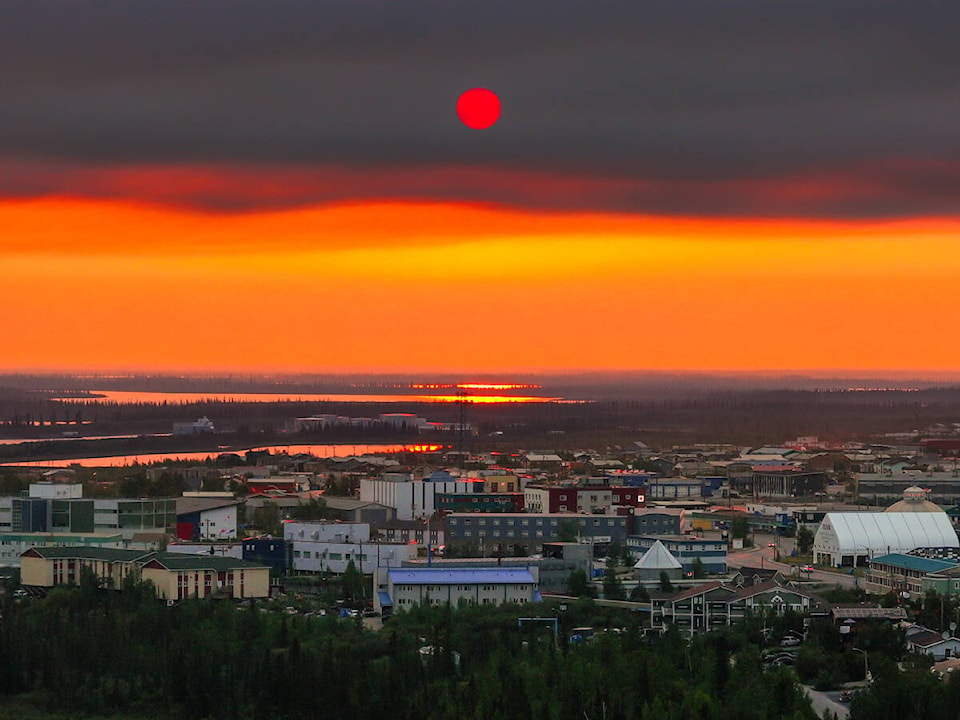It may be obvious, but Inuvik is experiencing thick smoke as a result of a nearby wildfire.
Environment Canada issued an air quality warning at 4:42 a.m. July 28.
“Wildfire smoke can be harmful to everyone’s health even at low concentrations. Continue to take actions to protect your health and reduce exposure to smoke,” reads the special air quality statement. “People with lung disease (such as asthma) or heart disease, older adults, children, pregnant people, and people who work outdoors are at higher risk of experiencing health effects caused by wildfire smoke.
“Stop outdoor activities and contact your health care provider if you or someone in your care experiences shortness of breath, wheezing (including asthma attacks), severe cough, dizziness or chest pains. Stay inside if you are feeling unwell and experiencing symptoms. Keep your indoor air clean. Keep your doors and windows closed if the temperature in your home is comfortable.”
Those who are able to afford air filters are told to stick to High Efficiency Particulate Air (HEPA) filters and not use filters which produce ozone. The advisory also asks residents to monitor their mental health, as feelings of anxiety and isolation may arise.
Anyone overwhelmed by the smoke is asked to go to a well ventilated place. In Inuvik, this means either the library or the Midnight Sun Complex.
“Take a break from the smoke by temporarily relocating or finding a location in your community with clean, cool air such as a library, shopping mall or community centre. Contact your local health or municipal authorities for more information,” reads the special notice. “If you must spend time outdoors, a well-fitted respirator type mask (such as a NIOSH certified N95 or equivalent respirator) that does not allow air to pass through small openings between the mask and face, can help reduce your exposure to the fine particles in smoke.
“These fine particles generally pose the greatest risk to health. However, respirators do not reduce exposure to the gases in wildfire smoke. It is important to listen to your body and reduce or stop activities if you are experiencing symptoms.
“Be sure to check on people in your care and those around you who may be more susceptible to smoke.
“Pay attention to information and direction from your local authorities and evacuate if told to do so.”
The smoke is coming from a wildfire about 30 kilometres away at Sitidgi lake. The NWT Live Fire map lists the fire as out of control, but being monitored. It is approximately 212 hectares in size and has been burning for three days. The fire was naturally caused and an initial attack has not commenced yet.
However, the Town of Inuvik says there is currently no threat to the community from the fire.
“At this time, the fire is being monitored by the GNWT fire crews and there is no risk to the community,” reads a July 27 notice posted to the Town of Inuvik’s Facebook page. “Town of Inuvik and GNWT representatives have met to review our respective emergency plans, and have identified any necessary actions and communications in response to this fire in the coming days.
“Any updates or community notices will be posted on the Town of Inuvik Webpage, social media and media outlets.”
The notice includes an overview of the town’s emergency response plan. It notes that if the situation escalates, the plan will be implemented.
“Depending on the scale of the wildfire, there could be evacuations,” says the overview. “Localized or small-scale evacuations may occur in parts of the town, because of an immediate threat to that area.
“Town wide or large-scale evacuations could occur if the threat is affecting the entire town. Careful considerations would be taken to evacuate vulnerable populations, such as people with medical challenges, those who are unhoused, and prisoners.
“Residents may need to be sheltered in a safe area or in a shelter that can withstand the potential impacts of the emergency. In either case several sites including the Midnight Sun Recreation Complex, East Three School and others have been identified as evacuation centres. There is a plan in place to receive, register, shelter, and supply evacuees with basic necessities.
“If an evacuation due to a wildfire were required, the town would work with the GNWT to understand the threat, determining risk areas, issuing alerts and orders, arranging transportation controlling traffic flow, maintaining public and property safety.
“The importance of community member preparation and actions in emergency situations, the actions and cooperation of community members is essential for the safety of the residents, as well as emergency responders.
“Understand that the focus of the town will be to address the immediate threat to life, critical infrastructure and to remove people from danger.
“There are several things that people can do to prepare for an emergency. Have a 72-hour emergency kit (essential food, water, medicine, first aid kit, eyeglasses, car keys, credit cards, cash, ID, cellphone chargers, communication devices, clothing.) Have a “keeper” bag or box for things you do not want to lose (personal or cherished items that are easy to carry, photos, jewelry, important papers). Even if not packed, keep a list, and know where they are so you can grab and go and have an evacuation plan for elders, mobility challenged family members, pets.”
